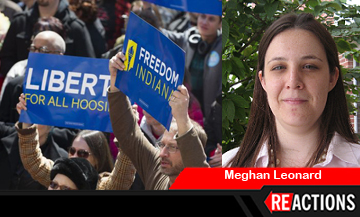A national backlash erupted after the Indiana legislature recently passed the Religious Freedom Restoration Act, or RFRA. Gov. Mike Pence has promised to “clarify” the act. Assistant Professor of Politics and Government Meghan Leonard explains the act, and what separates it from acts in other states.
Leonard:
The Religious Freedom Restoration Act in Indiana, at the federal level, and in other states, technically determines how cases involving questions of religious objections will be judged. In other words, it sets out for the state court how to balance a religious objection. The government (this is true of the federal government and the states that have a similar RFRA bill) can only intrude on an individual’s religious liberty if they have a compelling interest to do so, and it is done in the least restrictive way.
Many of the initial state RFRAs were passed in an initial wave after the federal RFRA nearly 25 years ago. The federal RFRA was in response to a Supreme Court decision that allowed for the denial of unemployment benefits to those who used peyote, a substance used in religious ceremonies in the Native American church. Today, the political intentions of the new state RFRAs are significantly different. These bills are coming on the heels of, and in response to, a significant expansion of same-sex marriage rights. The political intention of this legislation is clearly seen as a backlash to the changing nature of gay rights more generally.
There are some significant differences in the Indiana version that have made it more controversial. First, the Indiana bill expands to whom the law applies, by legislating more than an interaction between an individual and the state government. It significantly expands the definition of a person—allowing businesses, corporations, religious groups or other entities to use the law to challenge what they see as burdens to their religious liberty.
The change to the initial bill in Indiana adds protections for sexual orientation and gender identity from discrimination based on religious convictions. What many LBGT advocates argued for, but was not part of the change were blanket protections based on sexual orientation and gender identity as part of state law.
It has also been noted that President Barack Obama voted for a piece of very similar legislation in Illinois when he was a state senator. While then-senator Obama voted for the Illinois RFRA, this bill was less expansive than the Indiana one, and was not passed in response to expanding gay rights. One other note, in Illinois we have explicit protections based on sexual orientation and gender identity, so the RFRA could not be used to discriminate against the LGBT community here in Illinois.
I think the implications for the LGBT rights movement has been demonstrated most in the backlash to these laws. Groups as diverse as the NCAA, Apple, the ACLU, and even religious groups have responded very negatively to the legislation and its potential implications. It is clear that the case of LGBT rights has significant support among a diverse group of people and businesses. These concerns will be moot in Indiana and in all states with similar bills if and when it is determined that LGBT individuals are a protected class (not unlike race) and cannot be discriminated against based on their sexual orientation or gender identity.

